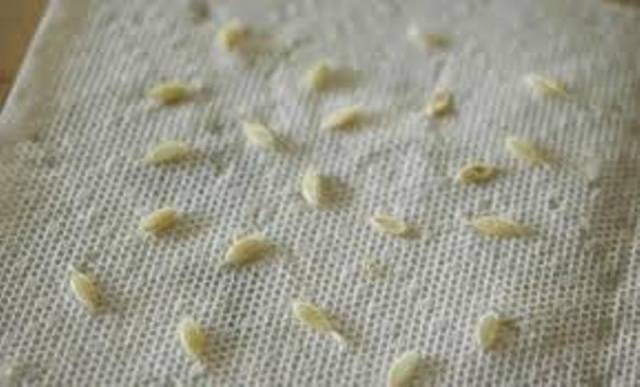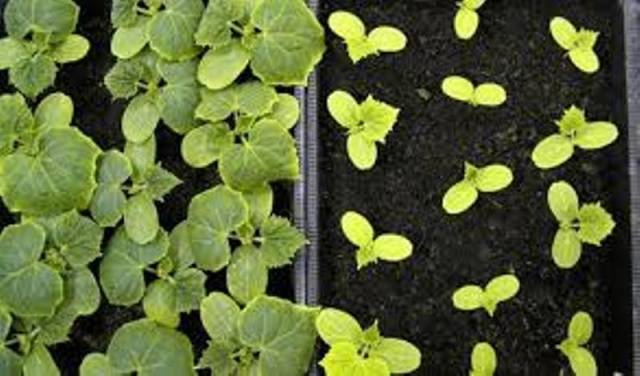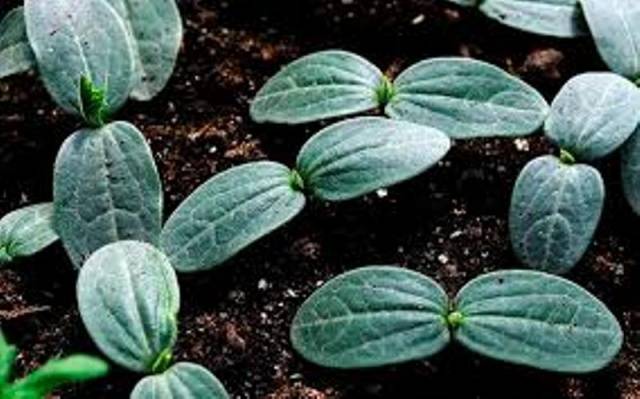Content
A good harvest starts with quality cucumber seeds. Whatever the method of growing cucumbers - greenhouse or open, pre-sowing preparation is of great importance for obtaining strong and healthy plants.
Collecting cucumber seeds for seedlings
The fruits of varietal cucumbers, intended for collecting seed, are kept on the bushes until fully ripe. The largest cucumber is not removed until it turns yellow. Then it is cut off and placed in a warm place for 5-7 days until it is completely soft. The cucumber is cut lengthwise and the pulp is scraped out along with the seeds, which is placed in a glass container with warm water. Cover with gauze (so as not to start flies) and leave to "wander" for several days.
As soon as all the seeds settle to the bottom, the film is removed and the jar is shaken. Empty cucumber seeds will immediately float to the surface and can be drained along with the water. The remaining seeds are thrown into a sieve or colander, washed with clean water and dried well. To do this, they are laid out on a plate or cling film.
After the seeds are completely dry, they are folded into a paper envelope on which the name of the variety and the collection date are written. The envelope is removed to a dry place for two or three years. The best germination rate for seeds 2-3 years old. After this period germination decreases, so they should not be stored longer.
It is possible to improve the quality of the younger seed. To do this, you need to create certain conditions for them. Fresh cucumber seeds are stored at 25 degrees in a dark and dry place.
Seed preparation for sowing
Seedlings of cucumbers are most often grown by the greenhouse method - under a film and in a warm room. The seed preparation process consists of four stages:
- Germination test;
- Disinfection;
- Hardening;
- Germination stimulation.
Germination test
Presowing preparation begins a month before sowing in the soil for seedlings. It is necessary to select healthy, large cucumber seeds, which will provide a high percentage of germination. Since it is impossible to determine this by eye even for experienced gardeners, a weak solution of table salt will help to do this.
The seed is poured with a solution. After 5 minutes, those seeds of cucumbers that have surfaced can be removed and discarded - they will not germinate. The remaining seeds are washed, dried and sorted by size. The largest and fullest of them will give a good harvest if grown correctly.
Warming up, feeding
After drying, the seeds need to be warmed up. This will help them to ascend faster. Warming up stimulates the formation of female flowers, which means that they will begin to bear fruit earlier. They are kept at a temperature of 28-30 degrees for a month. If there is no time for thorough preparation, then you can make intensive heating at 50 degrees.
Heated, washed and dried seeds need to be fed so that they sprout well. To do this, their soak in the nutrient mixture for several hours.It may contain wood ash, sodium humate or nitrophosphate... Melt water is also considered an active growth stimulant. After that, they are washed again, wrapped in a damp cloth and left for a day in a dark place.
Hardening
The seeds also need to be prepared for the fact that when they are planted in open ground, not only sunlight and warmth await them. For this, the seeds are gradually "accustomed" to low temperatures. For this, the room where they are waiting in the wings is periodically ventilated. You can put the seeds in the refrigerator for a day.
Disinfection
The causative agents of some cucumber diseases can also be found on the seed coat. Disinfection will not only help get rid of them, but will also increase the resistance of the plants. Disinfection is carried out by immersing them in a strong solution of potassium permanganate. Boric acid solution also works well.
Disinfect seeds, as well as to increase their germination and accelerate germination, treatment with ultraviolet rays will help. Irradiation is carried out for 3-5 minutes. To be effective, you must completely isolate the seeds from any light sources until the very sowing. After processing, they are placed in a light-tight bag.
The sowing material of cucumbers from the store with the F1 designation on the package does not need preliminary hardening and feeding. To obtain a good harvest, it is enough to determine the percentage of germination by germination immediately before sowing into the ground. Such seeds have already passed all stages of preparation before going on sale.
Growing seedlings
Before how to plant cucumbers in open or greenhouse ground, seedlings need to be grown from seeds. This method takes time, but has many advantages, including:
- Rapid plant growth;
- Long-term fruiting;
- Good harvest guaranteed.
And for this, the seeds must be germinated. You can learn more about how to prepare cucumber seeds, whether you need to germinate them, by watching the video:
Water for germination is defended at room temperature for at least a day. A cotton cloth soaked in water and aloe juice is laid out on the bottom of a flat dish. The prepared seeds are evenly distributed over it. From above you need to close with gauze, and spray with the same water. The optimum temperature in the room for germination is -20-25 degrees.
The first roots will appear 28-30 hours after soaking. Sprouted seeds should be immediately planted in the ground, without waiting for the sprouts to appear.
Each seed is placed in a separate cup filled with earth. The soil can be prepared in advance by mixing the soil with peat, humus and sawdust, which must be scalded with boiling water to remove the tar from them. These cups can be made of thick plastic wrap or thick paper - when planting in the ground by the transshipment method, it can be quickly removed without damaging the roots and leaving a whole earthen lump. The seeds are sown to a depth of 1.5-2 cm and sprinkled with water at room temperature. Cups with future seedlings are placed in a box and covered with foil.
In the first three days after sowing, the box with cucumber seedlings is placed in a warm place. The room temperature should not drop below 25 degrees. After the emergence of seedlings, the film is removed and the seedlings are moved to a well-lit and ventilated place.
Young plants need bright daylight for 10-11 hours a day. In the absence of natural sunlight (on cloudy days), additional lighting is needed.
Watering the seedlings begins as soon as the first leaves unfold. This must be done carefully so that the water does not get on the stems, but soaks the soil. It is convenient to do this with a regular teaspoon.
Seedlings ready for open field planting have a dense, strong stem, dark green, well-developed leaves and a strong root system.
By this time, the earth should warm up to 15-18 degrees, and the air - up to 18-20.A few days before planting, the cucumbers are taken outside in the daytime so that the plants adapt to the natural climate.
Conclusion
The process of growing cucumbers is long and laborious. But if you follow all the rules from collecting seeds to planting seedlings, then you can be absolutely sure that the result will more than pay off all the efforts expended, and plants that have received proper care will reward you with a good harvest of juicy and fragrant fruits.














